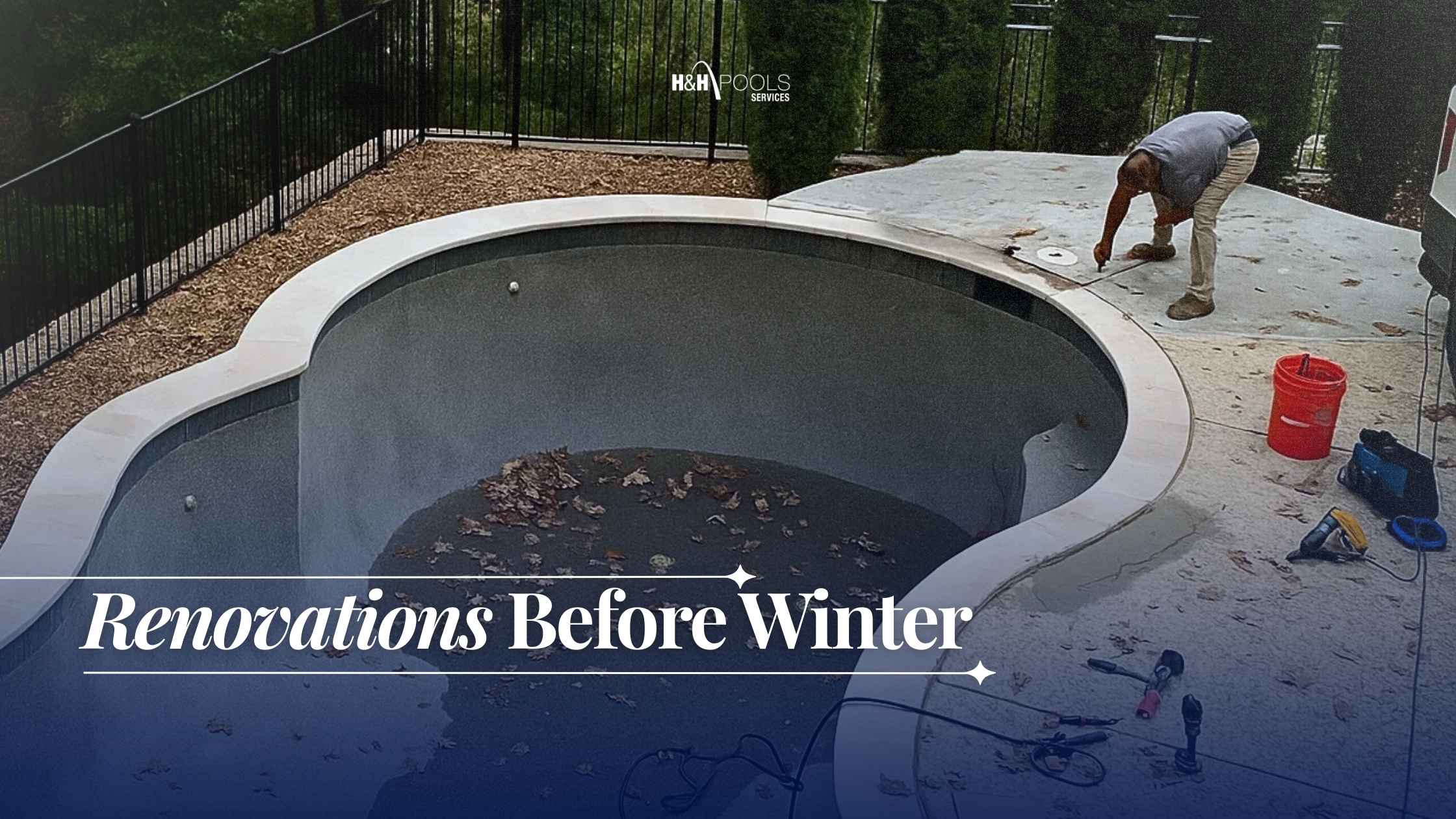How to Winterize a Pool: Renovations Before Winter & Closing Tips
As autumn settles in and the days grow shorter, pool owners face an important decision: how to winterize a pool before the cold months set in? While summer may feel like it just ended, late fall is actually one of the smartest times to tackle both pool closing and renovation planning. Closing your pool at the right moment helps prevent freeze damage and costly repairs, while using the off-season for upgrades ensures you’ll be ready to dive into a refreshed, updated pool once warm weather returns.
In this guide, we’ll break down how to winterize a pool step by step: why October is the ideal month to close, the essential pool winterization steps, how to avoid freeze-related damage, and the best renovation projects to start before winter sets in. Whether you’re focused on protecting your investment or planning next season’s upgrades, the choices you make now will pay off in a smoother, stress-free spring opening.
The Risks of Late Pool Closing
Fall is the natural transition point for pool closings. While some homeowners prefer to stretch out the season, delaying how to winterize a pool leads to putting your pool and your wallet at risk.
Here’s why the smart move is to close in October:

Benefits of Tackling Renovations Before Winter Sets In
Taking care of pool renovations winter offers several advantages that homeowners often overlook. By starting in late fall, you can avoid the spring rush when contractors’ schedules fill up quickly, often months in advance. Addressing issues such as cracks, leaks, or worn decking now also helps protect your pool structure from the freeze-thaw cycles that can make small problems much worse over the winter. Finally, tackling projects before the season changes allows for smarter financial planning, spreading costs out by starting in fall and finishing in spring, rather than taking on the full expense all at once.
Essential Pool Closing Steps
If you’re wondering how to winterize a pool the right way, here are the essential steps every homeowner should follow:
For extra protection, our pool repair experts can ensure your cover fits and seals correctly.
Planning Ahead for Next Season
Planning doesn’t end once you’ve learned how to winterize a pool. Taking care of equipment, supplies, and upgrades ensures spring success. Once your pool is closed, a few simple steps will make spring much easier. Start by inspecting your equipment, pumps, filters, and heaters, so any needed repairs can be handled before the busy spring rush. Ordering supplies early, such as chemicals and covers, also helps you avoid shortages and higher prices once warmer weather arrives. If you’ve been considering upgrades, fall and winter are the best times to add energy-efficient pumps, modern heaters, or automation systems, since contractors often have more availability.
Finally, don’t forget to check your pool cover during the colder months. Clearing away heavy snow or standing water prevents sagging and extends the life of your investment, ensuring your pool is protected until it’s time to reopen.
Leaf management is key in October. With heavy oak and maple shedding across Chesterfield, Kirkwood, and Webster Groves, adding a leaf net over your winter cover can save you hours of cleanup in spring.
Aim to close before the first hard freeze, typically late October or early November in Missouri.
Winter Prep Essentials for Pool Owners
Knowing how to winterize a pool also means understanding the biggest risks: freeze damage, water chemistry, and cover choice.
Save Time and Money
A properly winterized pool cuts spring cleaning costs by up to 40% and extends the life of your equipment and cover. Taking these steps now ensures a stress-free opening and a pool that’s ready to enjoy as soon as warm weather returns.
Renovation & Remodeling Planning Before Winter
While many homeowners focus only on how to winterize a pool, fall and winter are also the best seasons to start renovations. Many assume pool renovations must wait until spring, but in reality, the colder months are one of the best times to start. With your pool already closed, construction crews have a clear window to complete projects without interrupting your swim season. Winter scheduling also avoids the spring rush, when contractors book up quickly and timelines stretch longer. By starting in the off-season, you’ll enjoy a finished pool that’s ready the moment warm weather arrives.

Popular Renovation Projects to Start in Fall
Financing & Budgeting Considerations
Planning renovations in fall also gives you more flexibility with finances and scheduling. Many homeowners spread payments over several months, starting work before the holidays and completing upgrades by early spring. Contractors may also offer off-season pricing or shorter wait times, making the fall-to-winter transition one of the most cost-effective times to invest in your pool.
By treating fall and winter as your planning and building season, you avoid the headaches of last-minute spring projects and open your pool in style with brand-new features already in place.
Insights for Pool Industry Partners
- Trends in Off-Season Renovation Demand
Industry data shows a 25% increase in off-season projects, as more homeowners realize the benefits of fall/winter scheduling. - Collaboration Between Service Providers & Homeowners
Contractors and suppliers can use this downtime to build stronger client relationships and plan long-term upgrades.
Why Choose H&H Pools for Renovations & Closings
Our Expertise in Custom & Luxury Pools
From custom inground pools to pool remodeling and leak detection services, H&H Pools has decades of experience in pool repair, seasonal pool maintenance, and full-service renovation projects.
Local Service Areas We Proudly Serve
We provide expert pool services in Chesterfield, Creve Coeur, Des Peres, Edwardsville, Kirkwood, Ladue, St. Charles, Town and Country, Webster Groves, and Wentzville.
FAQs About Renovations Before Winter
Secure Your Pool Before the Cold Hits
Winter is right around the corner. Don’t wait until it’s too late. Schedule your late closing or renovation planning now with H&H Pools. With expert services across Chesterfield, Creve Coeur, Des Peres, Edwardsville, Kirkwood, Ladue, St. Charles, Town and Country, Webster Groves, and Wentzville, we’ll make sure your pool is ready for spring success.




